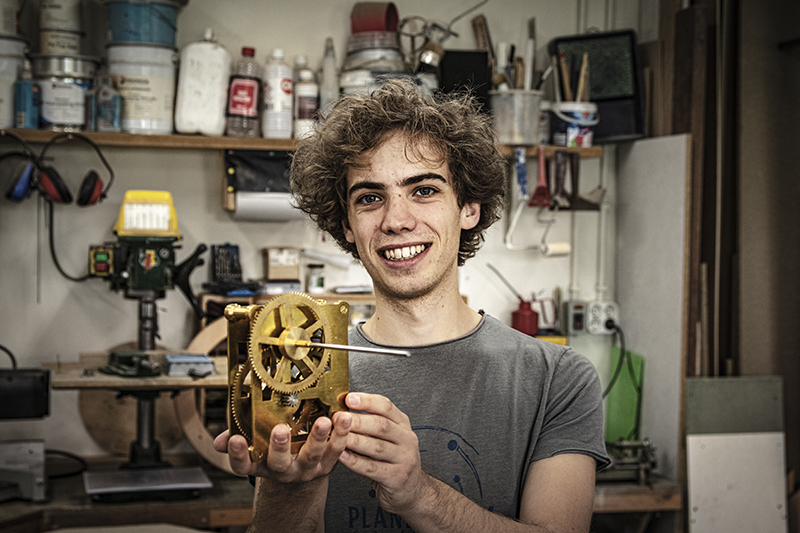Following Eise Eisinga to the stars
Daan is building his own planetarium
When Daan Vermaat visited Eise Eisinga’s planetarium as a kid, he couldn’t stop staring at the marvel before him. Eisinga, an astronomer in the Frisian town of Franeker, built his masterpiece into the ceiling of his house in 1781, reproducing the position of the planets with mathematical precision.
Back home, then five-year-old Daan grabbed his box of Lego and tried to recreate the planetarium. In the years to follow, he would use other Lego sets, books, and YouTube videos to learn about interlocking gears forming a mechanical whole and putting things into motion.
Fifteen years later, his fascination has only grown. In fact, he’s designed and is working on building his own planetarium. Not in his own home, like Eisinga, but in his parents’ workshop in Onstwedde, which is filled with machines, workbenches, shelves, and tools. Daan combines building his planetarium with his studies in astronomy at the UG.
Mathematical puzzle
He started his project in his final year of high school. On paper, he worked out how to build a planetarium that would fit on a round table with a diameter of 60 centimetres. It was one hell of a mathematical puzzle: the planets’ orbits have to be perfectly in sync with real time, and if even one cog is slightly too big or too small, everything is out of whack: ‘The calculations had been done before, but I redid them all myself. It was a lot of work.’
If I finish it in five years, it’ll be fast
In order to learn more about the mechanics of the planetarium, he went back to the one Eise Eisinga built, which happens to be the oldest working planetarium in the world. He had a long list of questions to ask the museum curator. Daan was also allowed to look behind the scenes in the attic, where he ever so carefully crawled among the various cogs. ‘It was amazing!’
The theoretical work he wrote in high school now functions as a manual for his own planetarium build. Daan started milling the cogs in March of 2019, while he was on his gap year. He had to make 88 cogs in total. He’s currently working on the axles and the frame, and the table is next. Then, he has to make sure that everything fits together.
‘If I finish the whole thing in five years it’ll be fast’, he says, laughing. ‘I’d estimate I’m about 10 or 20 percent of the way there right now. I’d like to spend more time on it, but a weekend is too short to get anything significant done and my studies keep me pretty busy. I can only really work on it during the holidays.’
Craftsmanship
He knows how special his project is: ‘In astronomy, they use computers for everything. A planetarium is this really old-fashioned thing. Back then it was the only way to learn anything about our solar system. But I love the craftsmanship involved in making it.’
With a woodworker for a father, Daan grew up handy. ‘I was always tinkering and fixing things’, he says. ‘During my gap year, I built a mobile home before I got started on my planetarium.’
You can make anything, as long as you’ve willing to spend time on it
The metalworking as part of his planetarium build required learning some new skills. ‘I’m using the workshop of one of my parents’ friends. His machines are like fifty years old, so I have to adjust everything manually.’ Filing down the cogs also takes a lot of work. ‘My parents’ friends has this philosophy: you can make anything, as long as you’re willing to spend the time doing it. I couldn’t agree more.’

Full house
In his case, he’s willing to spend years on it. Any time Daan isn’t working on the planetarium, the various parts are stored in the cabinets in his parents’ workshop. They are taking up an increasing amount of space.
Eise Eisinga’s wife reportedly grew increasingly frustrated with his strewn-about planetarium parts. When the planet Uranus was discovered, Eisinga wanted to utilise part of the living room to expand his planetarium, but his wife put a quick stop to that. Fortunately, Daan’s parents have no issues with his project. ‘It probably helps that mine is only the size of table, and not a whole house, like Eisinga’, he says, laughing.
I’ll never get rid of the planetarium
The things he’s learned designing his planetarium have helped him in his astronomy studies, he says. ‘I already knew all about Kepler’s Laws, which describe how planets orbit the sun. I’m also learning even more about things I researched during my high school project.’
Hobby
Conversely, his studies haven’t contributed to the practical design for his planetarium. ‘Those were finalised in high school.’ Daan’s planetarium will have two more planets and five more moons than Eisinga’s, since they were discovered in the past two centuries. Once this one is finished, he’d like to keep working on planetariums. ‘I really love the work, but perhaps it should be more of a hobby.’
Then again, he could always help build large telescopes. ‘It’s a different thing altogether, but still really technical. I’ve been asked to make a spectrograph part for the telescope at Zernike. And the UG is building a new telescope at Lauwersoog. I’d love to pay that a visit.’
First, he’ll have to finish his own project. The planetarium will get a special place in his home, and he intends to take it with him whenever he moves. ‘I’ll never get rid of it.’

